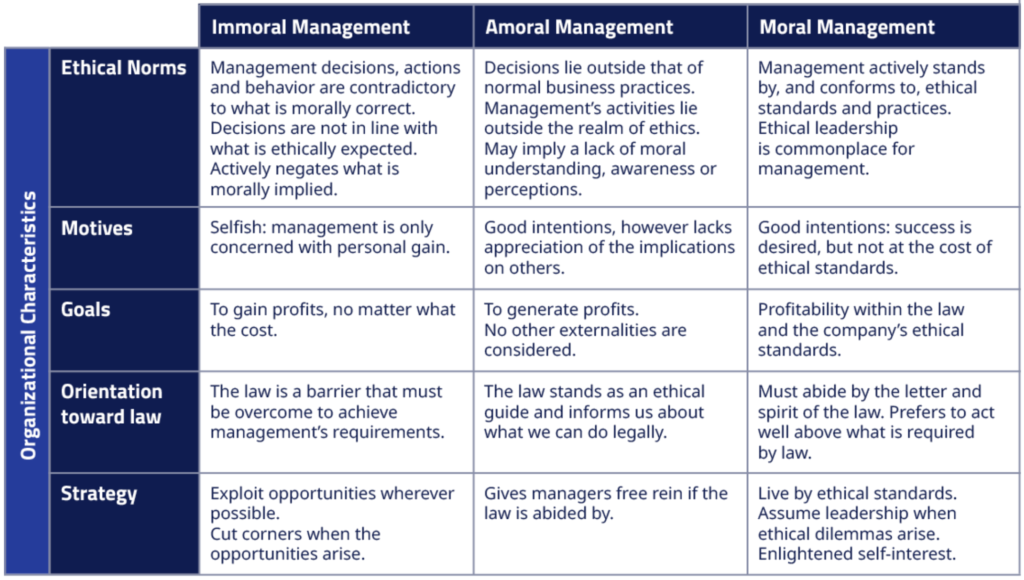Ethics in professional consulting is not always the first thing on the organizational agenda. But, having been described as there to help ‘identify and solve managerial and operating problems of the various institutions of our society’, consultants are bestowed with a considerable amount of trust and responsibility. Ethics should therefore be at the forefront of any professional consultant’s (and their firm’s) minds and actions.
Not all situations lend themselves to being easy ethical decisions. In the past, I have found myself having to question the actions or requests of others from time to time, whether it is on a piece of work we are delivering, how we are selling work, or our approach. At times we could find a conflict in what we are contracted to deliver and the “next piece of work”.
Making the right decisions
These ethical dilemmas are commonplace and to help us in navigating these, Michael Davis provides a seven-step guideto ethical decision-making that should be adopted by the consultant and the organization alike:
- State the problem – what is it about the situation that creates discomfort, presents a conflict of interest or ethical dilemma?
- Check the facts – what are the root causes of the issue? Do these still hold true and therefore is it still an issue?
- Identify relevant factors – what are the internal and external contributors to the issue?
- Develop a list of options – find ways and people that can help solve the issue – the more creative and imaginative the better – as long as it doesn’t lead to another ethical dilemma.
- Test the options – use these tests to ensure the solutions are appropriate:
- Harm: will this bring less harm than any other option?
- Publicity: if published in the Sunday Times, will it be okay?
- Defensibility: would this option be defendable in front of a committee?
- Reversibility: is this still a good option if the consultant or organization is negatively affected?
- Colleague: what is the response of objective colleagues with this option?
- Professional: how would this option be seen by the CMI’s Ethics committee?
- Organization: how would NTT DATA’s ethics officer and legal counsel react?
- Make a choice – understanding steps one to five, decide and act on the best route forward.
- Review steps one to six– limit the propensity of having to make these decisions again and learn from the process.
It is critical to drive the correct culture from the onset – the recruiting process – and then consistently drive the desired culture from the top down. Leadership can therefore be challenged to choose between revenue and ethics.
I believe certain principles guide the ethics of an organization, and these can be found in its culture. Culture is critical (as immortalized in Peter Drucker’s famous adage): an organization can have policies and codes in place, but if the culture is in contradiction to these, they will be futile. It is critical to drive the correct culture from the onset – the recruiting process – and then consistently drive the desired culture from the top down. Leadership can therefore be challenged to choose between revenue and ethics.
Professional consulting regularly faces ethical dilemmas through the type of work it conducts, as well as being at arm’s length from clients. This is why the alignment to a broader set of professional ethical standards, in keeping with a country’s legal framework, is crucial. This is due to the requirement of professional consultants to provide sound advice that will guide organizations through uncertainty. If this advice is not legally or ethically sound, the consultant may be contravening certain legal bounds.
A good example is that of data protection and integrity. As remote work and globalization become more commonplace, professional consultants need to be acutely aware of how data is accessed and transferred across jurisdictions, and whether this is acceptable legally and in line with the client’s policies.
Navigating ethical dilemmas
This is a critical skill set needed for all professional consultants, due to the raft of situations where ethics will be challenged – challenges that become more high-risk and prolific the more senior in the organization the clients are. To deal with these challenges, it is important to always refer to one’s moral compass, which should be closely aligned to that of the organization.
Dealing with ethical challenges therefore becomes significantly easier if the consultant has the backing of the organization. This behavior must be part of the organizational culture and reputation.
There are a number of ways to navigate ethical dilemmas, including Davis’s seven-step guide as outlined above, but this – as well as any other framework – will fail if the organization does not provide a safe space and culture to call out unethical behavior, or support others when they find themselves facing ethical dilemmas.
There needs to be a broad-based, conscious adoption by professional consulting organizations to be the guardians of ethics when advising clients, in the same way auditors are intended to be for financial reporting.
I feel that top-down culture, support and forums to keep each other honest are critical. There needs to be a broad-based, conscious adoption by professional consulting organizations to be the guardians of ethics when advising clients, in the same way auditors are intended to be for financial reporting. In his 1987 publication,In Search of the Moral Manager, Archie Carroll presents a valuable framework outlining the essential characteristics of moral management (see table below).

Immoral management often results from overtly selfish intentions, and not taking the client into account. Although actions may be within the law, they may be designed to find gaps and opportunities to exploit the client’s weaknesses and focus on those, and not what is in the clients’ best interests.
Amoral management is when a firm needs to develop a product or service, but doesn’t have the funding to do so on their own. Rather, they engage with their client, selling the output as proprietary (often for a limited time), on the premise that they pay for the development and tolerate delays that are often inevitable.
Mental and physical health, moral standards and personal values have taken priority; these areas are therefore clear focuses for organizations who wish to operate more ethically and enhance the experience for staff and clients alike.
Happily, moral management – where the wellbeing of staff and commitments to clients are well balanced – is on the rise. The best way to measure this is to understand whether any party is any worse off than before. As the world has evolved over the past couple of years, mental and physical health, moral standards and personal values have taken priority; these areas are therefore clear focuses for organizations who wish to operate more ethically and enhance the experience for staff and clients alike.
Real value
As organizations and leadership adopt the moral management approach as a standard, the moral compass and ethical standards of the organization and its professional consultants naturally follow suit. This results in significantly greater benefits that go beyond the deal, and reach further into staff retention, better reputation and ultimately significant growth and financial benefit.











